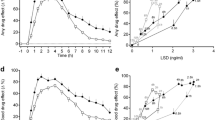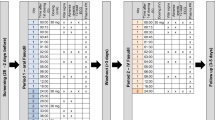Summary
The pharmacokinetics of 9-amino-1,2,3,4-tetrahydroacridine; tacrine, THA, was studied after intravenous administration and following the first and last oral doses of a seven week clinical trial involving 8 patients with amyotrophic lateral sclerosis, ALS. Two surgical patients given intravenous THA for reversal of postoperative sedation were also included. Plasma concentration of THA and in some cases the metabolite, 1-hydroxy-THA, were assayed using a selective and sensitive method with high performance liquid chromatography.
After an intravenous dose of 30 mg THA, the plasma concentrations were fitted to a two-compartment model. Plasma clearance showed a threefold interindividual variation with a mean of 2.42 l·h−1. Volume of distribution, Vα varied 100–680 l with a mean of 349 l. The plasma half-lives of distribution and elimination were 1.8 and 98.2 min, respectively. Oral bioavailability showed large interindividual differences and ranged 6–36% in the four subjects studied.
After seven weeks treatment with oral THA, plasma concentrations immediately prior to medication were below 10 ng/ml in three patients and above 100 ng/ml in two patients. At the same occasion the plasma metabolite concentrations considerably exceeded those of THA. THA medication was associated with side effects in the majority of the patients.
Similar content being viewed by others
References
Hunter AR (1965) Tetrahydroaminacrine in anesthesia. Br J Anesth 37: 505–513
Gordh T, W»hlin Å (1961) Potentiation of the neuromuscular effect of succinylcholine by tetrahydroamineacridine. Acta Anaesthiol Scand 5: 51–55
Gordh T (1962) Behandling av sömnmedelsförgiftningar (Swe). Nord Med 68: 132
Stone V, Moon W, Shaw FH (1961) Treatment of intractable pain with morphine and tetrahydromainacrine. Br Med J 471–473
Nybäck H, Nyman H, Öhman G, Nordgren I, Lindström B (1988) Preliminary experiences and results with THA for the amelioration of symptoms of Alzheimer's disease. In: Giacobini E, Becker R (eds) Current research in Alzheimer therapy. Taylor and Francis, New York, pp 231–236
Park T, Tachiki KH, Summers WK (1986) Isolation and the fluorometric high performance liquid chromatographic determination of tacrine. Anal Biochem 159: 358–362
Summers WK, Majovski LV, Marsch GM, Tachiki K, Kling A (1986) Oral tetrahydroaminoacridine in longterm treatment of senile dementia. N Engl J Med 315: 1241–1245
Kanesawa I (1977) Neurotransmitters and motor neuron disease. Jpn J Clin Med 35: 4025–4029
Nagata Y, Oluya M, Honda M (1981) Regional distribution of choline acetyltransferase and acetylcholinesterase activity in spinal neurons of motor neuron disease patients. Neurosci Lett [Suppl] 6: 571
Gillberg PG, Aquilonius SM (1982) Cholinerg, opioid and glycine receptor binding sites localized in human spinal cord by in vitro autoradiography. Acta Neurol Scand 72: 299–306
Whitehouse PJ, Wamsley JK, Zarbin MA, Price DL, Tourtelotte WW, Kuhar MJ (1983) Amyotrophic lateral sclerosis alterations in neurotransmitter receptors. Ann Neurol 14: 8–16
Puri SK, Hsu R, Ho I, Lassman HB (1988) Single-dose safety, tolerance and pharmacokinetics of HP 029 in elderly men: A potent Alzheimer agent. Curr Ther Res 44: 766–780
Ekman L, Lindström B, Roxin P (1989) Determination of tacrine and the 1-hydroxy metabolite in plasma using HPLC. J Chromatogr 494: 397–402
Gomeni R (1984) Pharm — An interactive graphic program for individual and population pharmacokinetic parameter estimation. Comput Biol Med 14: 25–34
Aquilonius SM, Hartvig P (1986) Clinical pharmacokinetics of choline esterase inhibitors. Clin Pharmacokinet 11: 236–249
Hartvig P, Wiklund L, Lindström B (1986) Pharmacokinetics of physostigmine after intravenous, intramuscular and subcutaneous administration in surgical patients. Acta Anesthesiol Scand 30: 177–182
Hartvig P, Lindström B, Pettersson E, Wiklund L (1989) Reversal of postoperative somnolence using a two rate infusion of physostigmine. Acta Anesthesiol Scand. 33: 681–685
Author information
Authors and Affiliations
Rights and permissions
About this article
Cite this article
Hartvig, P., Askmark, H., Aquilonius, S.M. et al. Clinical pharmacokinetics of intravenous and oral 9-amino-1,2,3,4-tetrahydroacridine, tacrine. Eur J Clin Pharmacol 38, 259–263 (1990). https://doi.org/10.1007/BF00315027
Received:
Accepted:
Issue Date:
DOI: https://doi.org/10.1007/BF00315027




